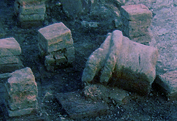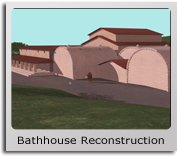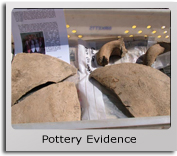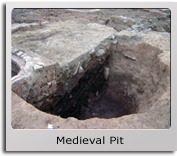
|
 |
||

|
Bathhouse A deep trench running away from the main site on the west side but parallel to it produced a large piece of amphora*. Amphora represented a large proportion of the pottery assemblage from the site in general but there was of little in the way of domestic material. This suggests the site was a public building rather than a domestic residence or town house, which sometimes had heated rooms. The slight fall in the deep trench suggests that it was probably the water supply to the main building. Adding to this, on the north side of the site and dating slightly early, Ian pointed out an area of post holes and hearths, where some industrial activity had been carried out. Scrap pieces of lead indicate that this was probably the workshops where the Romans were producing the lead used for lining pools or tanks for holding the water. Assessing all this evidence, Ian and his team are convinced that this site was indeed a bathhouse. In Britain as a whole, bathhouses are very often associated with forts but, without positive evidence for one in the Wigan area (although this has not been ruled out), the suggestion is that it was probably attached to a mansio**. |
||

|
High Status Ian explained that the whole site was evidently of a high status and seemed to be built generally in one phase. The width and depth of the hypocaust foundation trenches alone were testament to the importance of the structure. Trenches had been cut into the bedrock of the sloping hillside of Millgate to provide a level surface to build on, indicating a large investment in time and manpower. Most of the stonework had been removed from the foundation trenches but, where it had survived, the quality of construction was of a high standard. Quite unusually though, the excavations revealed that this walling had been almost totally robbed out in antiquity (in fact in the Roman period) suggesting that it had been deliberately dismantled and may have been taken elsewhere. Ian also commented on how even more remarkable was the age of its construction. Pottery evidence puts the date of occupation between the late 1st century and early 2nd; a date which has since been confirmed with evidence from archaeo-magnetic analysis for the last firing of the stokehole. This came in at 137 AD, a date which coincides with a general push by the Romans into Scotland - a period of advance which eventually resulted in the formation of the Antonine Wall stretching from the Clyde to the Forth. |
||

|
Post-Roman Although the main structure was built in one phase there was some later activity on the site in the Roman period, but this amounted to very little. As well as the previously mentioned hearth inserted in the hypocaust room, a deep trench was cut in the area around the plunge pool. This was offset from the pool by about a metre or so to the north and west side, but the function of this trench remains unclear. The archaeologists found no evidence of further occupation until the Medieval period when a number of pits were dug on the periphery of the site. Two of these pits were quite large and yielded a fair assemblage of pottery dating mainly from the 12th to 14th centuries. This has increased the total number of Medieval potsherds from the excavations to over 300. It is difficult to underestimate the importance of this material in our understanding of Medieval Wigan. To put it into context, the total amount of sherds discovered previously in the whole of Wigan is only about one tenth of the pottery discovered here at this one site. Next |
||
|
*Amphora were large pottery vessels usually associated with the transportation of wine, oil or fish paste. **A mansio was the Roman equivalent of a hotel or travelodge where important dignitaries could stay on their travels. Many had attached facilities such as bathhouses or gymnasiums (similar to a leisure centre). |
|||